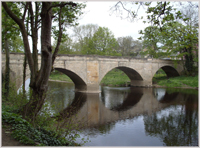 Having been a keen walker most of my adult life and having completed many challenge walks and National Trails, my thoughts began to turn to writing a
Having been a keen walker most of my adult life and having completed many challenge walks and National Trails, my thoughts began to turn to writing a
walking book of my own.
My home city of Leeds seemed to be the perfect place to start, being surrounded by countryside and only a short distance to the Yorkshire Dales and Wolds.
But, where to finish?
Keep going until I fall into the sea was the answer, and a finish point on the East coast beckoned, with Britain’s first seaside resort of Scarborough, being the selected destination.
 I decided on a step-by-step guide, obviating the need for maps, so that absolute beginners could take part.
I decided on a step-by-step guide, obviating the need for maps, so that absolute beginners could take part.
To add to the interest for walkers, I also decided to include local and natural history points of interest, relevant to the areas through which the walk passed. Thus began an intensive twelve months of poring over maps, internet searches and library visits, not forgetting the important bit of actually doing the walk myself. Once the route had been decided, and with the assistance of friends, we walked the whole of the 104 mile route and individual sections several times, to make sure that my notes were accurate and easy to follow.
 Bed and Breakfast accommodation along the route for the benefit or weary walkers was an important factor and many of them were visited during my travels. Photography was the key to attracting people to the walk and I took scores of pictures to show what the route was like and to form a gallery on the supporting website.
Bed and Breakfast accommodation along the route for the benefit or weary walkers was an important factor and many of them were visited during my travels. Photography was the key to attracting people to the walk and I took scores of pictures to show what the route was like and to form a gallery on the supporting website.
The walk itself is very varied and traverses some absolutely beautiful countryside. There are no mountains to conquer, nor even any significant hills and can be achieved by anyone who is reasonably fit. The walk commences at the Black Prince statue in Leeds City Square. Passing from the ultra modern centre, it goes through Victorian housing developments and quickly into fingers of parkland. The countryside surrounding Leeds is soon reached and passes the outdoor film set of the fictional village of Emmerdale before entering the grounds of Harewood House.
 The River Wharfe valley is then followed, as the walk passes through the village of Linton, and on to the historic market town of Wetherby. Still following the Wharfe, picturesque villages come and go as an ancient countryside Roman Road is taken to Fulford, a suburb of York. From here, the walk crosses vast agricultural plains to the battle site of Stamford Bridge where in 1066, the Viking invaders were repulsed for the final time on English soil.
The River Wharfe valley is then followed, as the walk passes through the village of Linton, and on to the historic market town of Wetherby. Still following the Wharfe, picturesque villages come and go as an ancient countryside Roman Road is taken to Fulford, a suburb of York. From here, the walk crosses vast agricultural plains to the battle site of Stamford Bridge where in 1066, the Viking invaders were repulsed for the final time on English soil.
The route then goes upriver, following the River Derwent through the Howardian Hills Area of Outstanding Natural Beauty, to Kirkham Abbey and Malton. The chocolate box village of Thornton Le Dale is next, before entering the North York Moors National Park and the impossibly beautiful forests of Wykeham and Dalby.
A brief respite at remote Harwood Dale precedes a last push to the coast. The last few miles follow the cliff path before a beach and headland walk brings you to the finish line at Scarborough’s South Bay.
There are so many interesting buildings, places and local history facts within the book that it would be a long job to list them all, but as a mere taster:
-
 Where was the world’s first moving picture exhibition and what fate befell the inventor?
Where was the world’s first moving picture exhibition and what fate befell the inventor? - Which town is equidistant from London and Edinburgh?
- Why did feuding brothers build breweries next to each other?
- Which race-horse’s bloodline is contained in 85% of all British race-horses today?
- Where is the world’s longest railway station seat?
The walk may be viewed at www.whiteroseway.co.uk where copies of the book at £7.99 plus p&p are now available to purchase.
Happy walking!
Paul Brown is a retired Police Inspector and has held a lifelong passion for the outdoors. He is an experienced fell and mountain walker and has completed many challenge walks and National Trails.
 Where was the world’s first moving picture exhibition and what fate befell the inventor?
Where was the world’s first moving picture exhibition and what fate befell the inventor?










